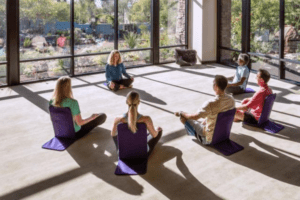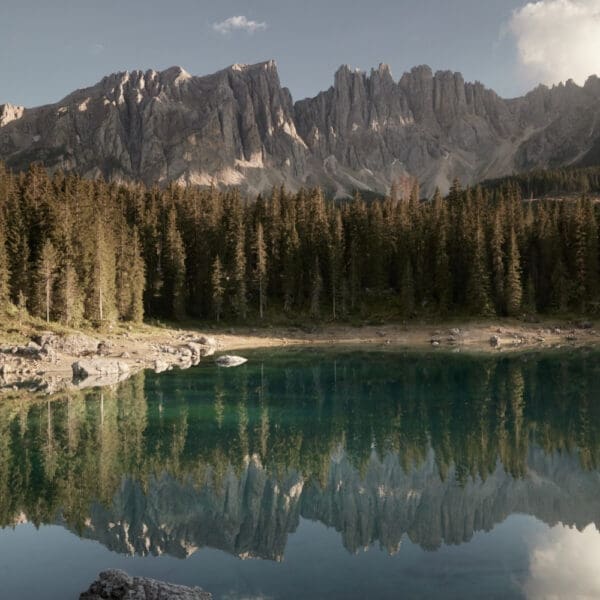
According to the Global Wellness Institute, wellness tourism was worth $651 billion globally in 2022, and is forecast to grow to a massive $1.4 trillion by 2027. An article by Łódź University found that the post-COVID wellness tourism sector represents one of the fastest-growing tourism market segments globally. In addition to this sector’s rapid growth, wellness travellers tend to spend much more per trip than travellers from other tourism sectors.
How can hoteliers benefit from this trend? How can you offer activities to aid the healthy balance of mind and body and how can you integrate a wellness lifestyle into your business? Does this development have to cost you a lot?
What is wellness tourism?
The Global Wellness Institute (GWI) defines wellness tourism as “travel associated with the pursuit of maintaining or enhancing one’s personal wellbeing”. On a basic level, wellness tourism is often synonymous with destinations offering yoga and spa retreats or detox packages, but with the rising trend of travellers looking to escape the stresses of life and improve their well-being, the sector is far more extensive. Fortunately, there are more affordable approaches to incorporating elements of wellness or retreat culture into your hotel.
Does your hotel already offer wellness?
One of the most convenient characteristics of wellness tourism is that it is multifaceted and could be in the form of food, fitness, relaxation, or local culture – so hoteliers may already have elements of wellness tourism in place at their hotels, maybe without even realising it and probably without giving it quality marketing presence.
Perhaps your hotel has gym facilities, a chef who knows vegan recipes, luxurious rooms which promote rest and relaxation or even an underutilised spa? In addition to areas where you may already have some wellness offerings, there are other ways you can include health and wellness into your property without it costing much if anything at all.
“What constitutes a wellbeing holiday is subjective,” Justin Francis, co-founder and CEO of Responsible Travel told National Geographic. “I’d say a painting holiday in the Scottish Highlands or a wild camping experience can be as much about wellness as a vegan Pilates retreat. Wellness holidays simply allow you to rest and revive in your own way, mentally and physically.”
Ways to include wellness tourism at your property
MOVEMENT
Embracing physical fitness epitomises a proactive approach to wellness, enhancing one’s overall health and safeguarding against lifestyle diseases. Studies increasingly demonstrate that regular exercise not only improves physical health but also reduces stress and fosters a happier state of mind.
If your hotel already has a gym, ensure that your machines are running well and guests know what to do with them. Ideally, you should have someone on hand to offer advice on exercises. If staff aren’t an option, have clear workout guides up for guests to follow. In addition to keeping the gym looking clean and neat, make sure it features in your hotel marketing and ensure that all of your online travel agent profiles have gym facilities listed as one of your hotel amenities.
Even if your hotel doesn’t have dedicated workout facilities, you can still promote fitness and movement as part of your wellness offerings. Consider innovative options like partnering with fitness companies to provide in-room workout programs accessible via Smart TVs or in-room tablets. You can also enhance guest experience by offering hotel-branded fitness props like mats and weights for in-room use.
Additionally, collaborating with local Pilates, Yoga, or other fitness instructors to host classes in communal areas, conference rooms, or poolside settings can further enrich your wellness offerings and cater to diverse guest preferences. providing information or coupons for nearby leisure centres, jogging trails, and cycling routes further enriches the guest experience and promotes holistic well-being.
The Even Hotel has positioned physical fitness as one of its top USPs and it sits front and centre in their marketing collateral. The Even offers access to a state-of-the-art fitness centre as well as in-room workouts via a workout-on-demand app. Guests can request certain fitness gear to be sent to their rooms and Premium rooms have an in-built ‘fitness zone’ which includes TRX resistance loops and even an interactive spin bike.
According to Raul Ortiz, VP of global marketing and brand management for EVEN Hotels speaking to Well and Good magazine “Currently, 80 per cent of guests who book with us plan on working out in their room, and most actually do once they stay with us.” This is a good indication of how many guests are looking to keep up with their fitness routine while travelling.
OUTDOOR ACTIVITIES
According to MasterCard’s report on Travel Industry Trends, spending on things increased a measly 12% from 2019 to 2023, while travellers spent 65% more on experiences in the same period. Guests want to feel connected to the local culture and natural surroundings and are shying away from a cookie-cutter room in a hotel approach.
Combining this desire for cultural immersion and experiential travel with the wellness benefits of just being outdoors gives you the best of both trends. Beyond suggesting walking routes and nearby vista destinations, hoteliers can collaborate with local outdoor adventure companies to offer guided hikes, nature walks, or cycling tours, or team up with local wellness practitioners, such as Yoga and Pilates instructors, to organise outdoor classes in scenic locations. These partnerships not only enhance guests’ outdoor experiences but also foster mutually beneficial relationships, as cross-promotion can lead to increased visibility for both parties.
Find out more about why being a good neighbour is good for business
Moreover, arranging day trips to nearby attractions or cultural sites showcases the hotel’s commitment to offering comprehensive vacation experiences. By curating unique and immersive excursions, hotels demonstrate an understanding of guests’ desires for enriching and memorable travel experiences. Whether it’s exploring local landmarks or embarking on off-the-beaten-path adventures, guests will appreciate the opportunity to connect with their surroundings and indulge in wellness-focused activities during their stay.
“Luxury retreats that offer mountain hikes, forest bathing, and wild swimming even in cold waters adopting the Wim Hof cold therapy method, will be on the list of high-end travellers looking for a dive into the wild in 2024.”
Hotel Saranac offers guests a digital ‘explorer concierge,’ the Field Guide, detailing a myriad of outdoor activities in the local area. From hiking the Saranac Six (a group of mountains surrounding the hotel’s local area) to canoeing in the Historic “Seven Carries” Route to mountain biking, road biking and even bobsledding, this hotel seems to have it all – even though none of it belongs to the hotel!
SPA & BEAUTY
While establishing a full-scale spa facility may not be feasible for all hotels, there are numerous ways to incorporate spa-like experiences into your wellness offerings. Enhance guests’ relaxation and well-being by providing luxurious amenities such as spa-quality soaps, shampoos, and lotions in guest rooms, along with plush robes and gowns for added comfort. You could also include a selection of herbal teas to be pre-ordered to the guest’s room before check-in, offering unique blends which promote rest and rejuvenation. Or have a full tea selection in each room, allowing guests to control what blend (and associated wellness benefit) they would enjoy.
Consider partnering with local freelance massage therapists or beauty practitioners to offer massage treatments, waxing, facials, or manicures, providing guests with a comprehensive spa-like experience during their stay without leaving the comfort of their accommodations. You could set aside a dedicated room with scenic views as a massage and treatment room, where guests can enjoy personalised massage sessions tailored to their preferences, or invite freelance therapists to take their equipment to guests’ own rooms.
Additionally, consider offering exclusive discounts or coupons for nearby spas, allowing guests to explore additional wellness options in the surrounding area.
You could also offer a unique turn-down service, including a bath drawing bonus, which could include various aromatherapy items, such as scented candles, bath oils and even flowers in the bathroom. Turning down the lights and offering a candle-lit bath is sure to make anyone feel rested and pampered. If you want to spend a little more, invest in a hot tub for some of your premium rooms.
Although the Waldorf Astoria in Chicago boasts a spa facility on-site, they also offer their signature massage or a couples massage in the guest’s room, a facial in partnership with Knesko skincare (with a complimentary glass of diamond-dusted Veuve Clicquot). This means guests don’t have to leave the comfort of their bedroom to experience the spa experience. Any hotel could achieve this with freelance massage therapists and pre-bookings.
SLEEP
Offering a full night’s rest will ensure that your guests are already well on their way to feeling well.
Disruptive sleep patterns can wreak havoc on our hormonal balance, cause weight gain and exacerbate mental health disorders. An interesting article from the Institute of Medicine sums up the findings on sleep deprivation, “After decades of research, the case can be confidently made that sleep loss and sleep disorders have profound and widespread effects on human health”. One aspect that every hotel will have is a bedroom for your guests, so how can you make the most of these spaces, enhance your guest’s sleep quality and use that in your hotel’s wellness offerings?
Sleep-focused tourism is emerging as a trend in the hospitality sector, with many hotels marketing their sleep programs as a primary feature. While it can be as basic as high-quality bedding and blackout curtains, it can become as technologically advanced as a ‘smart bed’ which controls temperature and can even adjust its firmness depending on where the guest is in their sleep cycle.
If you’re not in the market for an AI-enabled mattress, your hotel’s focus on sleep wellness can begin with something like a sleep-focused turn-down service. Offer a turndown service where staff dim the lights, play soothing music, and leave a calming herbal tea to signal the transition to bedtime. You can include some sleep amenities such as scented eye pillows, aromatherapy options, white noise machines or soothing music playing in the rooms. You could even include more specific items such as a meditation CD or a relaxation program guests can follow before bed.
One hotel that is getting the sleep tourism trend right is the Royal Champagne Hotel and Spa. Guests staying in the Junior Suites are treated to premium linens, blackout curtains, and a serene, soundproof environment. The Royal Sleep Kit greets them with sleep mist, melatonin drops, a Morphée meditation guide, and a satin sleep mask. The Spa offers a soothing one-hour candle massage, while Le Bellevue restaurant serves a sleep-focused menu with a “Sleeping Beauty” mocktail. As guests dine, the team prepares a calming bedtime ritual in-room, including a sleep mist, curtain closure, and herbal tea with sweet treats for a restful night’s sleep.
HEALTHY EATING
If a property is looking to position itself as a wellness destination on any level, getting food and beverage right is critical. It’s essential to offer balanced meals emphasising fruits, vegetables, and vitamins and offer various options for different dietary preferences.
While this can initially seem overwhelming, offering vegetarian, vegan and gluten-free options is possible with a little research and training. Once these items have been integrated into your menu, they need to be communicated to both current and potential guests.
Any changes in your menu to cater for dietary requirements should be showcased on your social media, in client emails and on your website. Make sure potential guests know they can stay with you while still being able to enjoy the foods they require. According to Statista “The number of vegans in the EU is forecast to grow from about 6.6 million in 2023 to almost 8.3 million by 2033.” While not a huge percentage of the population globally, it does help to be one of the hotels in your area offering vegan options to those few million.
Ensuring the accuracy and quality of the food served is paramount. Well-trained staff knowledgeable about different diets, and how the food is prepared, who can guide and engage with guests effectively can foster trust and satisfaction.
Aside from changing your existing menu to include various options such as vegan, vegetarian, gluten-free, dairy-free or sugar-free options, your property can also start to include healthy options in your breakfast buffets, in your mini-bar offerings and even offer healthier options behind bars or in vending machines.
Guests who care for their bodies also often want to know that their products are sustainably and ethically sourced. Getting local food producers on board and explaining the origins of the raw ingredients can help attract and delight guests. Better yet, offering nutrition courses, healthy cooking demos and interactive moments with chefs and guests can all help to put you on the wellness tourism map.
“Hotels need to embrace sustainability, nutrition, multi-sensory design and psychology, and expand on the idea of what healthy eating looks and feels like,”
– Charles Spence, professor of experimental psychology, University of Oxford.
One hotel making the most of the food and beverage wellness trend is Aro Ha Wellness Retreat. Amongst their vast array of health and wellness amenities and activities, they offer healthy meals, cooking demonstrations and an Ayurvedic cooking class.
WELLNESS EVENTS, WORKSHOPS AND CLASSES
Hosting wellness-focused classes and events can effectively meet the expectations of guests seeking opportunities to improve their physical and mental well-being, without requiring extensive investment in full-time staff or spa facilities. Collaborating with local practitioners can provide a rich array of workshops and classes, whether hosted at your property or at their venues. To foster a mutually beneficial relationship, consider offering transport services for guests attending off-site workshops, along with negotiated discounts.
Expanding beyond traditional wellness activities, hotels can offer creative and engaging options. For instance, sound healing sessions with Tibetan bowls or gong baths can provide unique relaxation experiences. Similarly, DIY skincare workshops using natural ingredients allow guests to create personalised spa products they can take home. Aromatherapy blending sessions or classes on creating herbal teas can also be popular and relatively inexpensive to set up.
Advertise the regular classes in brochures and market classes with a less structured timetable in the reception and on social media.
One hotel offering unique and interesting wellness events is the Canyon Ranch in Woodside, California. They offer events such as personal development talks and workshops, women’s empowerment circles, Yoga retreats and meditation classes.
As wellness tourism continues to gain momentum, it’s not just the travellers benefiting from self-improvement; the broader tourism economy, including hotels and local businesses, also reaps the rewards. It also seems that what we have seen of wellness tourism is just the beginning and that it’s unlikely to slow down any time soon. By implementing simple yet effective changes, hoteliers can position themselves at the forefront of the wellness movement without requiring significant capital investment.




















